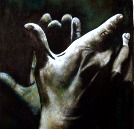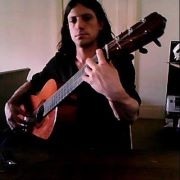Welcome to one of the most active flamenco sites on the Internet. Guests can read most posts but if you want to participate click here to register.
This site is dedicated to the memory of Paco de Lucía, Ron Mitchell, Guy Williams, Linda Elvira, Philip John Lee, Craig Eros, Ben Woods, David Serva and Tom Blackshear who went ahead of us.
We receive 12,200 visitors a month from 200 countries and 1.7 million page impressions a year. To advertise on this site please contact us.
|

|
|
solea al golpe
|
You are logged in as Guest
|
|
Users viewing this topic: none
|
|
Login  | |
|

   
NormanKliman
Posts: 1143
Joined: Sep. 1 2007

|
 RE: solea al golpe (in reply to mezzo) RE: solea al golpe (in reply to mezzo)
|
|
|
You'll see the name "soleá al golpe" sometimes but all it really means is that the rhythm is a little faster (with or without guitar). It could refer to bulerías or soleás. For example, in the videos, Curro Mairena's cante and most of what Bastián Bacán sings are soleás de Alcalá, and Vicent Soto sings bulerías por soleá.
The only difference in accompaniment is the differece between soleá and bulería por soleá (also called soleá por bulería and bulería para escuchar), being that soleás end with groups of two lines of verse and some styles of bulería por soleá can end with groups of three lines. Here are some examples from the videos, with the last lines of verse (conclusion, cambio) in italics:
(Curro Mairena, soleá de Alcalá)
Las tres Marías subieron
y al castillo de Alcalá
al castillo de Alcalá
y al castillo de Alcalá
para vestir de un negro luto
y al cante por soleá
(Bastián Bacán 0:10, bulería por soleá)
Compañera no regañes
agacho la cabecita
válgame Díos primita
el campo no tiene llave
(Vicente Soto 0:49, bulería por soleá)
Santiago y La Plazuela
Santiago y La Plazuela
son dos barrios de Jerez
adonde ha nacido Manuel Torre
prima de mi alma
y Juan Mojama también
(Vicente Soto 1:27, bulería por soleá)
Mujer te tengo que ver
mujer te tengo que ver
de rodillas en penitencia
por lo mala que has sido
delante del Gran Poder
(Vicent Soto 2:01, bulería por soleá)
Porque yo te había querido
prima mía sin darme cuenta
yo te he querido sin darme cuenta
ahora que quiero yo olvidarte
porque conmigo eres mala
qué trabajito me cuesta
(Vicente Soto 3:03, bulería por soleá)
Dejarme ay dejarme
Dios mío vivir tranquilo
dejarme vivir Dios mío a mi manera
si no me meto yo con nadie
omaíta de mi alma
y nadie conmigo se meta
Notice that in the rest of Vicente's cantes the conclusion uses only two lines of verse.
(3:42, bulería por soleá)
Y bulería por soleá
ay como ha cantado La Moreno
no se volverá a escuchar
(4:01, bulería por soleá)
Santiago y San Miguel
Santiago y San Miguel
y son dos pilares del cante
que mantienen a Jerez
son los pilares del cante
que mantienen a Jerez
More examples:
http://www.canteytoque.es/bulsol.htm
http://www.canteytoque.es/mediocompas%20ing.htm
_____________________________
Be here now.
|
|
|
|
REPORT THIS POST AS INAPPROPRIATE |
Date Dec. 1 2010 8:16:42
 |
|

   
NormanKliman
Posts: 1143
Joined: Sep. 1 2007

|
 RE: solea al golpe (in reply to mark indigo) RE: solea al golpe (in reply to mark indigo)
|
|
|
Hi Mark,
quote:
...if i really want an old falseta i can slow it down and pick it off the recording myself, or something approximating to it.
It's not always that simple. In 78-rpm format alone there are literally thousands of recordings, many of which were never re-released on vinyl, cassette or CD. Although things are generally the same from one disk to the next, some guitarists recorded ideas on just one or on a few of their recordings. Also, some old-time players recorded some very complicated falsetas that aren't easily transcribed (I'm not talking about warp-speed picado). Often, it takes a long time just to play them up to speed in order to be able to judge the accuracy of what you've transcribed. If you're interested, check out Antonio Moreno (recorded with Niña de los Peines and others). His p-i-p falsetas (the "old alzapúa" technique of Melchor, Morao, etc.) are extremely hard to play because of the added slurs, and the tempo is crazy fast.
quote:
.... but the admin task of sorting all that out before i can even start is so big i usually just go and play guitar instead....
Yeah, until now I've sort of been scratching my head, too. The problem is that the Solers' system of classification is regional (Alcalá, Cádiz, etc.), so each group is necessarily a mixed bag of different kinds of soleás. However, in the last two weeks I've noticed that there are four basic patterns comprising the greater part of approximately 100 different styles of soleá. I'll try to post some information soon on this new system of classification.
_____________________________
Be here now.
|
|
|
|
REPORT THIS POST AS INAPPROPRIATE |
Date Dec. 12 2010 8:32:34
 |
|

   
NormanKliman
Posts: 1143
Joined: Sep. 1 2007

|
 RE: solea al golpe (in reply to Ricardo) RE: solea al golpe (in reply to Ricardo)
|
|
|
quote:
...going way back, the slowest you ever encountered?
Mid-1970s as far as I can tell, but again, it's not something I've paid much attention to because I don't like it. Same for siguiriya, and I've heard other people make the same complaint. Nowadays even cosmopolitan veteran singers will do the "slowlea"  . I may be wrong, but fast soleás seem to be the result of taking a "rural" approach, if you know what I mean. . I may be wrong, but fast soleás seem to be the result of taking a "rural" approach, if you know what I mean.
By all means, feel free to argue, because, as I've been saying, I haven't paid much attention to the phenomenon. Years ago, I asked Blas Vega if he thought that soleás and siguiriyas used to be faster. He agreed and unsurprisingly put the blame on Antonio Mairena. I'll have to double check, but I think Mairena's slow cantes are only on his last two or three recordings, and they're alongside the standard fast-tempo versions.
Mairena's "Esquema histórico..." from 1976 might be one of the first of the slow recordings (not all of it is slow). It's certainly the only slow one I've listened to repeatedly because I studied it extensively many years ago. Although I thought I knew every nook and cranny (and isn't that just like flamenco?  ), I very recently realized that there's a half-compás in there. OMG! ), I very recently realized that there's a half-compás in there. OMG! 
http://www.canteytoque.es/joaquin1am127.mp3
Mairena might have been experimenting in this recording, but I think he was also having heart problems at the time, which is what killed him shortly after making his next recording.
_____________________________
Be here now.
|
|
|
|
REPORT THIS POST AS INAPPROPRIATE |
Date Dec. 13 2010 14:59:15
 |
|

   
mark indigo
Posts: 3625
Joined: Dec. 5 2007

|
 RE: solea al golpe (in reply to NormanKliman) RE: solea al golpe (in reply to NormanKliman)
|
|
|
quote:
It's not always that simple.
no, i appreciate that. I have lots of old recordings, and a fair number of transcriptions. What I was trying to say is that with all due respect firstly to the maestro's of the past and secondly to yourself, your afición, and the work you have put into this, the falseta collections are not my point of focus. If I learnt/ studied the solea falsetas for example, I would probably have to heavily adapt them to make them into "slowlea" for dance! But the cante is of interest, even if it is sung slower these days, esp. for baile. Without having singers local to here, the only way to learn is from recordings. I need to get deeper into the different forms, styles, variations etc. etc. but it's hard to know where to start. A "cante course" would be ideal!
|
|
|
|
REPORT THIS POST AS INAPPROPRIATE |
Date Dec. 13 2010 16:43:03
 |
|

   
NormanKliman
Posts: 1143
Joined: Sep. 1 2007

|
 RE: solea al golpe (in reply to mark indigo) RE: solea al golpe (in reply to mark indigo)
|
|
|
quote:
The problem is that the Solers' system of classification is regional (Alcalá, Cádiz, etc.), so each group is necessarily a mixed bag of different kinds of soleás. However, in the last two weeks I've noticed that there are four basic patterns comprising the greater part of approximately 100 different styles of soleá. I'll try to post some information soon on this new system of classification.
quote:
I need to get deeper into the different forms, styles, variations etc. etc. but it's hard to know where to start. A "cante course" would be ideal!
Just thought I'd follow up on this with a post as I'm adding the aforementioned information to the Spanish-language version of the soleares webpage, and it'll be a while before I get everything up and running in both languages.
The four basic patterns are:
1) De incio (starting): AB-BB-CD-CD or AB-AB-CD-CD. Four-line verse, nearly always heard at the beginning of a series of soleás. This is a very common pattern (19 styles, 7 of which are well known).
2) De transición (transition): A-A-BC-BC. Three-line verse. The most widely used pattern (38 styles). Repeats the first line of verse using the same melody twice.
3) De transición/cierre (transition/ending): ABC-BC. Three-line verse, each sung one after another and often in a single breath.
4) De cierre (ending): AAA-BC-BC. Three-line verse, linking and/or fragmenting the lines of verse. Although this pattern is used in only three styles (Joaquín 3, Mellizo 2 and Paquirri 3), one of these cantes is nearly always used to end a series of soleás.
Each of the four patterns can be further divided into cantes that imply II-I and those that imply I7-IVm (in the beginning, because the ending is nearly always the same cambio). These two harmonic patterns are the most common, but others include V7-I (Carapiera), VI7-II (Serneta 4, Juaniquí 4) and II-III (Caracol, Jerez anonymous, Yllanda 1, R. Moreno 1).
There are only 17 of nearly 100 styles that don't fit into one of the four patterns (Serneta 1 is A-AB-CD-CD, Paquirri 1 is ABB-CD-CD, some of the apolás are ABCDAB, etc.) Five styles can't really be associated with any specific pattern because they've been recorded in different ways. There are another three styles that I haven't been able to analyze because I haven't come across any recordings yet. Another thing to keep in mind when matching styles and patterns is that any three-line verse can be substituted with four-line verse (provided that the meaning isn't lost) by starting with the second line and singing the first line in the conclusion. For example, there are very old recordings of Pastora and another of Perla de Triana singing Mellizo 2 as BBB-CD-AB although the normal pattern is AAA-BC-BC.
What's really interesting is that many regions or alleged creators have most or all of the four patterns attributed to them, which means that you could limit a series of soleás to just that region or creator and there'd be an opening cante, a transitional cante and an ending cante. The best example is Joaquín el de La Paula and the four styles attributed to him (this is what makes Mairena's 1976 recording so great, dry as it may be). Another interesting thing is that some of the newer styles seem to fill the gaps existing among the combinations of patterns and harmonic implications of the traditional repertoire. For example, Antonio Mairena's Jerez-based styles 3 and 4 imply II-I in the beginning whereas I7-IVm is much more common for Jerez. Another example is Camarón's "Amarillo y con ojeras" (from a video with Tomate, not yet included in my study), because he's using a pattern that repeats the second line of verse several times over a III chord (modulating with VII7).
_____________________________
Be here now.
|
|
|
|
REPORT THIS POST AS INAPPROPRIATE |
Date Dec. 27 2010 14:43:21
 |
|

   
NormanKliman
Posts: 1143
Joined: Sep. 1 2007

|
 RE: solea al golpe (in reply to Ricardo) RE: solea al golpe (in reply to Ricardo)
|
|
|
Thanks Ricardo. I spent a few weeks studying before drawing my own conclusion about the four patterns, but I'm sure they've been described before. I'd appreciate it if anyone could let me know if they've seen something similar anywhere else.
Here are Caracol's cantes from the video:
(Joaquín el de La Paula 1: AB-BB-CD)
Permita Dios que si vienes
con la grande intención de dejarme
con intención de dejarme
con intención de dejarme
en la mitad del camino
se abra la tierra y te trague
(Joaquín el de La Paula 1: ABCD)
Fuentecita cristalina
los arroyitos eran caudalosos
y para los que bien te quieren
el camino es largo y rocoso
(Joaquín el de La Paula 2: ABC)
Yo no sé lo que le dio
y a la hierbabuena madre
que era verde y se secó
(Caracol, several styles)
Ay qué dobles de campanas prima (echoes of Paquirri/Ribalta)
qué dobles de campanas prima (like Frijones but returns to tonic)
creyeron que era una reina (like Frijones)
una reina no era (extra tercio of bulería larga)
que era una pobre gitana
It's all pretty anarchic, which doesn't make it any less authentic (Torre and Talega abbreviated cantes very often, probably because of their reduced lungpower), but I think in the last one he's using the peculiar structure of the bulería larga, described upthread and here:
http://www.canteytoque.es/mediocompas%20ing.htm
So, the closest pattern we can saddle it with might be something like:
A-A-B-X-C
In the bulería larga and in pattern 2 described upthread, the "A" verse is repeated with the same melody, but Caracol uses two different melodies (although returning to the tonic at the end of both). The "X" line of verse is usually "prima de mi alma" or something similar, but see the linked page for a few different alternatives (it's hard to say whether some are three- or four-line verse). As described on the linked page, what makes this pattern peculiar (and distinct from soleás) is the three-line unit in the ending (B-X-C). This doesn't seem to happen much in the bulería corta, which is usually just ABC (like pattern 3 described upthread). The bulería corta, then, is very much like a "real" soleá.
quote:
Buleria corta and buleria larga both fall into similar patterns as as the solea patterns...
No, be careful there. As I've just said, the "three-line-unit" ending (B-C-X) doesn't happen in any style of soleá. Of course, great creators like Caracol are going to do things like that once in a while, but it's more of an exception to the rule. The styles of soleá Paquirri 1 and Ribalta use a three-line unit at the beginning of the cante, but it's a different kind of idea.
quote:
Why are they called "buleria" and not some other form of solea?
As you know, all the cantes called bulería por soleá (SpB, "para escuchar," etc.) have their fast bulería versions. What I've heard and read is that those fast versions were the original cantes, and somebody slowed them down one day for BpS. However, those supposedly original cantes don't really show up on the old recordings in a way that might support that theory, so I don't really know what to tell you. It does seem clear though that there are fast bulería versions of those BpS cantes and fast bulería versions of "real" soleás and that the former are older than the latter (on recordings, anyway). This leads me to think that oral tradition might be right in this case, although I can't make that claim with much confidence (or even say confidently that I've thought this through). The only distinguishing factor that I see clearly is that, except for the bulería corta, the other BpS cantes use patterns of lines of verse that are different from "real" soleás.
By the way, I've asked Manuel Morao (Moraíto's uncle) about BpS and one of the things that he said was that they never used to say "bulería larga" or "bulería corta." The next logical question would be, "Well, what did you call them, then?" but I'm afraid we haven't gotten that far yet. 
_____________________________
Be here now.
|
|
|
|
REPORT THIS POST AS INAPPROPRIATE |
Date Dec. 27 2010 16:01:14
 |
|

   
NormanKliman
Posts: 1143
Joined: Sep. 1 2007

|
 RE: solea al golpe (in reply to mezzo) RE: solea al golpe (in reply to mezzo)
|
|
|
Hi Mezzo,
quote:
...understand "your code"
Like I said, someone else must have described those four patterns in a book or something. Rather than the "ABCs," it's more interesting to try to figure out the style of each cante. As I'm sure you've noticed, nearly all of the great singers have recorded variations on those four patterns, especially Manuel Torre. The patterns should be interpreted as stylized templates or very rough sketches and not as rules.
The structures you posted are correct, although in the cante you've labeled as number three (the fourth one he sings) he repeats the first line of verse, so it'd be AABC-BC. Also, the last cante is a juguetillo or whatever you want to call it, which is more like a cantiña, so it wouldn't really fit into any of the soleá patterns.
Good luck trying to pinpoint the styles! The high notes of the ending of the style attributed to Machango are present in nearly everything that Gaspar sings in this video. I highly recommend his last recording "Casta" with Antonio Moya, for the cante, the toque, the verse and the engineering.
_____________________________
Be here now.
|
|
|
|
REPORT THIS POST AS INAPPROPRIATE |
Date Dec. 27 2010 18:56:22
 |
|

   
NormanKliman
Posts: 1143
Joined: Sep. 1 2007

|
 RE: solea al golpe (in reply to mezzo) RE: solea al golpe (in reply to mezzo)
|
|
|
quote:
well i have to admit that i only realized this 4 patterns with this post
I'm gonna pay it more attention from now on...
quote:
how does one recognize the solea structure part ?
I mean the [ 1.De incio - 2.De transición - 3.De transición/cierre - 4.De cierre ]
Based primarily on 4 pattern verse or are there other ways?
As I said in my last post, the patterns should not be interpreted as rules. The "soleás de incio" are pretty well defined, but it doesn't mean that they can only be used at the beginning. It wouldn't make sense to sing a "soleá de cierre" anywhere but at the end of a series of soleás, but you could also end the series with one of the cantes from the "transición/cierre" group. "Soleá de transición" doesn't really mean anything. The patterns are just ways to help understand the differences and similarities among the nearly 100 styles of the Solers' classification. The only way to learn those styles is to spend a lot of time listening to them and comparing them. It also helps to know how popular each style is, because there are some ancient soleás (Rafael Moreno 1 and 2, for example) that you're never going to hear, so you don't have to "waste time" with those styles. I'm adding this information to my webpages now, but it's going to take a while. Maybe I can post a table or something similar here; give me a minute.
EDIT: Okay, tables aren't going to work here, but this is the information I'm working on now, roughly translated from Spanish:
Pattern 1: AB-BB-CD-CD/AB-AB-CD-CD
Classic model of soleá de inicio. With four-line verse, the cante starts with the repetition of a compound musical phrase (two different phrases in two lines of verse) that resolve to the tonic at the end of the second and fourth sung lines. The first sung lines can be AB-AB or AB-BB and the last sung lines can be CD-CD or CD-AB (in nearly all styles, there is great freedom of expression for the repetition of the conclusion).
Popular: (II-I) Mellizo 1, Andonda 1. (I7-IVm) Joaquín 1, J. Talega, Noriega, Ollero, Machango
Known: (II-I) Lorente, Triana 1. (I7-IVm) J. Ramírez
Not popular: (II-I) Roezna 1, Onofre 3, Mazzantini, Borrico, Sordillo 2, Triana 5, Breva. (I7-IVm) Mairena 1, Serneta 2
Other ways of singing four-line verse:
A-AB-CD-CD: Serneta 1, Fillo 2 and Onofre 1. The first line of verse is sung separately, then the first two lines are sung together.
ABB-CD-CD: Paquirri 1 and Ribalta. The second line of verse is repeated, forming a three-line unit.
ABCD: Matrona 1, Fillo 1, Joselero and Yllanda 3. The four lines of verse are sung one after another.
ABCDAB: Silverio 1-2 and Enrique Ortega. Three soleás apolás whose melodies involve the chord progression VI-III-VI-II-I. In the styles of Silverio, the chord progression means that the cante has to have six sung lines of verse.
Pattern 2: A-A-BC-BC
Transitional cantes. With three-line verse, the first line is repeated unlinked and with the same melody.
Popular: (II-I) Juaniquí 2, Andonda 2, Serneta 5. (I7-IVm) Frijones 2.
Known: (II-I) A. Talega 1, Jilica 1, Joaquín 4, Paquirri 2 and 4, Frijones 3, Juaniquí 1, Quino, Charamusco, Serneta 3. (I7-IVm) Aurelio, Frijones 1, Juaniquí 3.
Not popular: (II-I) Onofre 2, Mairena 3, Serneta 7, Yllanda 2, Triana 2-3. (I7-IVm) Mellizo 3, Andonda 3, Santamaría, Cagancho 1-2, Matrona 2, Oliver, Mairena 2, Ballesteros, Triana 4
Pattern 2 is used in the styles Carapiera (V7-I), Serneta 4 (VI7-II) and M. Caracol and Jerez (II-III).
Pattern 3: ABC-BC
Transition/ending styles, sung with three-line verse, linking the lines.
Popular: (I7-IVm) Joaquín 2
Known: (II-I) Pinea. (I7-IVm) A. Talega 2, Roezna 2, Serneta 6
Not popular: (I7-IVm) Jilica 2, Cádiz
Pattern 3 is used in the styles Juaniquí 4 (VI7-II), Yllanda 1 and R. Moreno 1 (II-III).
Pattern 4: AAA-BC-BC
Ending styles. Three-line verse with linked and/or fragmented lines. The styles are Joaquín 3, Mellizo 2 and Paquirri 3. Although there are only three styles to this pattern, singers nearly always end a series of soleás with one of these cantes.
Other ways of singing three-line verse:
AAA-BC-BC: Morcilla, Frijones 4, Mairena 4 and Pepe Torre. The lines of verse are arranged as in pattern 4 but without linking. In this way, three-line verse can be adapted to melodies that start with two or more different musical phrases, such as those of pattern 1.
AABC: Francisco Amaya and El Portugués 2. Four different musical phrases sung with three-line verse. In this way, three-line verse can be used for melodies that are sung over four consecutive or linked lines of verse.
The remaining styles have been recorded with several different arrangements and can not be matched to a single pattern: Chozas 1-2, José de Paula, Portugués 1, Sordillo 1. I haven't been able to find any recordings of the styles Rafael Moreno 2 and Emilio Abadía 1-2 so they're not included here.
_____________________________
Be here now.
|
|
|
|
REPORT THIS POST AS INAPPROPRIATE |
Date Dec. 27 2010 19:48:41
 |
|
 New Messages New Messages |
 No New Messages No New Messages |
 Hot Topic w/ New Messages Hot Topic w/ New Messages |
 Hot Topic w/o New Messages Hot Topic w/o New Messages |
 Locked w/ New Messages Locked w/ New Messages |
 Locked w/o New Messages Locked w/o New Messages |
|
 Post New Thread
Post New Thread
 Reply to Message
Reply to Message
 Post New Poll
Post New Poll
 Submit Vote
Submit Vote
 Delete My Own Post
Delete My Own Post
 Delete My Own Thread
Delete My Own Thread
 Rate Posts
Rate Posts
|
|
|
Forum Software powered by ASP Playground Advanced Edition 2.0.5
Copyright © 2000 - 2003 ASPPlayground.NET |
0.078125 secs.
|


 Printable Version
Printable Version

















 New Messages
New Messages No New Messages
No New Messages Hot Topic w/ New Messages
Hot Topic w/ New Messages Hot Topic w/o New Messages
Hot Topic w/o New Messages Locked w/ New Messages
Locked w/ New Messages Locked w/o New Messages
Locked w/o New Messages Post New Thread
Post New Thread